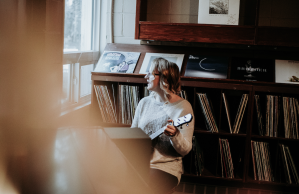
- With people everywhere falling head over heels for Disney’s “Encanto,” it’s the perfect opportunity to highlight the emotional impact of music on our lives.
- Even science is proving that our love for music is a genetic trait, a uniquely human experience.
- Though the “Encanto” soundtrack is quickly becoming beloved, under deeper examination, the characters are harnessing the creative process, an important part of the experience behind music therapy.
- This power of song to draw intense feelings out of us is the essence of music therapy and this unique counseling approach can help us to process hard times and difficult experiences.
- We don’t need to be musicians to find benefits from music therapy—we just have to listen to what we’re feeling.
Nothing else has the ability to power us through our workouts and make awkward elevator rides a little bit more bearable. That’s right; it’s hard to imagine a world without music. It’s probably an understatement to say that music is taken for granted; we don’t always recognize the mental sway and large-scale appeal that it holds.
Movies become famous for their soundtracks, advertisements become catchy for their jingles, and even sporting events like this year’s Super Bowl LVI incorporate music to attract more than just football fans. You might say it’s because we just like music. But under closer examination, music may help us express and add emotion to our lives in ways that other mediums just can’t accomplish.
And that’s the gist of music therapy, a therapeutic approach that aims to bridge the gap between the powerful emotions that we tend to suppress, and songs that can pull them out of us. Whether we’re playing or listening, music is a powerful tool to be used in both therapy and our personal lives to find healing and reclaim our sense of self.

Why Does Music Have Such a Deep Emotional Appeal?
Music is a deeply human expression, and the experience of singing, keeping rhythm, and feeling emotions that are tied to chord progressions and song structures is part of our very DNA. Parasocial relationships and celebrity obsessions aside, our connection to music runs in our blood. Scientists believe that music helped our ancestors to bond, forming stronger cultural ties, family units, and a tighter-knit sense of community.
From church choirs to tribal melodies, music is experienced and expressed around the world, and is an essential part of nearly every culture. Songs are used to convey emotion through shared experiences, from:
- Mourning a breakup (Taylor Swift, anyone?)
- Processing the death of someone close
- Yearning for success (pretty much every Queen song)
- Celebrating happiness or joy
- Exploring masochism or hedonism
- Venting our anger or frustration (the core of punk and Hip-Hop)
What makes music special is a combination of language, rhythm, melody, and harmony. These four factors blend together, working to activate regions in our brain that dictate emotional expression, language processing, and inhibition control.
“Encanto” Highlights the Creative Process in Music Therapy
One of the hottest animated movies right now is the Disney film “Encanto”. Set in a fictional universe, where nearly every member of a multi-generational Latino family is gifted with magical powers, one might at first gloss over the deeper subjects at work in the film. “Encanto” means ‘charm’ in English and the movie is aptly named—the songs are very catchy. Under closer scrutiny though, each character in the film has a personal struggle that revolves around their poor self-image, and dysfunctional family dynamics that drive the plot home.
But from a therapeutic perspective, the characters are actually processing their inter-generational trauma through music therapy, using a technique known as the creative process. In therapeutic sessions, the creative process involves clients actively taking part in creating music, helping them to work through difficult life situations that may involve feelings of grief, anxiety, depression. Part of this therapeutic technique can include instruction on how to play an instrument, and through learning, a client can then begin to analyze their emotional connection to music.
For example:
- The urge to play fast-paced or minor chords (“sad” sounding melodies) may indicate that a client is stressed or frustrated. They may be guided to think critically about what’s prompting their uncomfortable feelings.
- A counselor or therapist may direct you to play a soothing, uplifting song as a way to cope with feelings of hurt, anger, or depression. In this way, music therapy can be incorporated into a broader cognitive behavioral therapy (CBT) lens.
There are many more methodologies that mental health professionals may use to assist clients in processing what they feel or have experienced. But by taking part in the creative process, which might include singing along to the soundtrack of “Encanto” (which is pretty hard not to do), the cathartic power of music comes to life.
Try the Benefits of Music Therapy Out for Yourself
Truly, the best way to experience the benefits of music therapy is to connect with a therapist or counselor who specializes in music therapy. Emily Simonian, Licensed Marriage and Family Therapist (LFMT) at Thriveworks in Washington, DC, and Head of Learning, points out that we don’t have to be musical in order to reap benefits. “Music therapy isn’t just about playing an instrument or singing,” she says. “In a music therapy session, you might just listen to music, tune into your thoughts and emotions and then discuss with your therapist.”
Not much of a musical virtuoso? Don’t fret. While a counselor who specializes in music therapy can offer some tutelage if you don’t play any instruments, Simonian says,“You don’t have to know how to play or be musically inclined at all. It’s more about feeling your emotions and expressing them using sounds.” Simonian also explains that we can do some emotional processing on our own to work through tough situations or past events alongside music therapy sessions.
For music fans, Simonian had a few tips to share to help you start exploring the thoughts and feelings evoked by your favorite tracks. Some of her recommendations include:
- Engaging in critical listening: “Think of yourself as a sponge soaking up information from songs in the same way you gather information when reading—the difference with music is that the information you’re digesting is emotional,” says Simonian.
- Noticing the difference in subject matter between songs: Simonian says, “If you listen to a song that makes you happy, that song produces a dopamine rush that changes your emotional state and creates an emotional attachment to that song. If you listen to a song that makes you sad, that song potentially pulls up many difficult thoughts and again, triggers your emotional state.”
- Remembering that a therapist or counselor can help you dive deeper: As Simonian reminds us, “because music can also trigger challenging and intense thoughts and feelings, working with a therapist to process your experience can produce better mental health results.”
- Trying to write a song, even if you don’t have experience: “If you want to use music on your own to cope or process emotions, you can try writing lyrics about how you feel and singing them, listening to songs you love and tuning into the positive emotions experienced, dancing to music, or making sounds with non-musical instruments even if you aren’t musical,” Simonian says.
But there’s no need to make things complicated, as Simonian explains. “Tapping a beat with your hands or feet, or playing with windchimes can be meditative and the sounds can be relaxing.”
Finally, the most impactful aspect of music therapy is the unique way it can aid us in expanding our emotional awareness. “Emotional recognition becomes easier after music therapy because music amplifies emotions and may speed up the process of pulling up suppressed feelings,” explains Simonian. Okay—so you may not burst into song at the slightest prompting after starting music therapy. But maybe it’s time to face the music and the role it can play in helping us to rediscover the “Encanto” in our everyday lives.













